-
 Relatively thick iron tsuba of rounded square form with slightly elevated rim decorated in carving (sukidashi-bori) and yellow brass (shinchū) inlay (suemon-zōgan) with legendary creatures (humans with cow heads) in a pine tree forrest on the face, and a horned man with a stick hunting a rabbit in the woods on the reverse. Large hitsu-ana possibly cut off later on. In the beginning of the 20th century such tsuba were usually attributed to Fushimi-Kaga school. This one may be attributed to either Ōnin or to Heianjō. The latter seems most plosible because of the thick web and dull patina. The technique may also be called "shinchū-zōgan". Momoyama or early Edo period. Unsigned. Dimensions: 72.3 x 68.4 x 4.1 mm
Relatively thick iron tsuba of rounded square form with slightly elevated rim decorated in carving (sukidashi-bori) and yellow brass (shinchū) inlay (suemon-zōgan) with legendary creatures (humans with cow heads) in a pine tree forrest on the face, and a horned man with a stick hunting a rabbit in the woods on the reverse. Large hitsu-ana possibly cut off later on. In the beginning of the 20th century such tsuba were usually attributed to Fushimi-Kaga school. This one may be attributed to either Ōnin or to Heianjō. The latter seems most plosible because of the thick web and dull patina. The technique may also be called "shinchū-zōgan". Momoyama or early Edo period. Unsigned. Dimensions: 72.3 x 68.4 x 4.1 mm -
 Iron tsuba of almost round form with a brass outlined circular opening (sukashi) in the bottom adorned with the Myriad Treasures [takaramono, 宝物] and winter motifs inlaid in cast brass (suemon-zōgan); hitsu-ana possibly cut later, both plugged with shakudo, nakaga-ana fitted with copper sekigane. According to Merrily Baird*) (2001), the symbolism of Myriad Treasures “is associated with the Seven Gods of Good Luck, who carry them in a sack”. Among the treasures, which are said to ensure prosperity, long life, and general good fortunes, are (reading clockwise from the top):
Iron tsuba of almost round form with a brass outlined circular opening (sukashi) in the bottom adorned with the Myriad Treasures [takaramono, 宝物] and winter motifs inlaid in cast brass (suemon-zōgan); hitsu-ana possibly cut later, both plugged with shakudo, nakaga-ana fitted with copper sekigane. According to Merrily Baird*) (2001), the symbolism of Myriad Treasures “is associated with the Seven Gods of Good Luck, who carry them in a sack”. Among the treasures, which are said to ensure prosperity, long life, and general good fortunes, are (reading clockwise from the top):- Sake set [shuki, 酒器], namely flask, ladle, and cups
- Cloves [choji, 丁子]
- Purse of inexhaustible reaches [kinchaku, 巾着]
- Magic mallet [kozuchi, 小槌]
- Key to the storehouse of the Gods [kagi, 鍵]
- Rhombus, or Lozenge (hosho, 方勝), with the second ideograph meaning victory.
- Sacred (or wish-granting) gem, or jewel [hōju, 宝珠]
- Hats of invisibility [kakuregasa, 隠れ笠]
-
 Large and thin iron tsuba of round form (width > height) decorated with the design of a tiger sheltering in bamboo in suemon-zōgan brass inlay. A fragment of tail inlay is missing. Bamboo leaves on the reverse. According to Merrily Baird [Symbols, p. 166], tiger sheltering in bamboo symbolizes "weak giving shelter to the strong". Momoyama period. Unsigned. Dimensions: 90.8 x 91.2 x 3.4 (center), 3.1 (rim) mm. Custom wooden box. NBTHK Certificate № 4001593.
Large and thin iron tsuba of round form (width > height) decorated with the design of a tiger sheltering in bamboo in suemon-zōgan brass inlay. A fragment of tail inlay is missing. Bamboo leaves on the reverse. According to Merrily Baird [Symbols, p. 166], tiger sheltering in bamboo symbolizes "weak giving shelter to the strong". Momoyama period. Unsigned. Dimensions: 90.8 x 91.2 x 3.4 (center), 3.1 (rim) mm. Custom wooden box. NBTHK Certificate № 4001593. -

Thin iron tsuba of round form pierced with six three-leaf wood sorrels (katabami) in ko-sukashi and inlaid with brass decoration along the rim. Kozuka-hitsu-ana probably cut at a later date.
Late Muromachi or Momoyama period, 16th century. Dimensions: 78.0 x 77.7 x 2.5 mm. -
 Heianjō tsuba, carved and inlayed in brass with a somewhat primitive design of rocks, plants, and waves, and a man in a boat beside two jakugo stone baskets on the face and a religious structure (stupa, grave stone) on the reverse. Muromachi or Momoyama period.
Heianjō tsuba, carved and inlayed in brass with a somewhat primitive design of rocks, plants, and waves, and a man in a boat beside two jakugo stone baskets on the face and a religious structure (stupa, grave stone) on the reverse. Muromachi or Momoyama period.Size: 83.2 x 82.4 x 3.6 mm; 149.2 g
The Carlo Monzino Collection of Japanese sword fittings and swords (Sotheby's, London, 18 June 1996. p. 12-13) №9 provides an illustration of the similar tsuba with the following description: Heianjo tsuba, carved and inlayed with rocks, plants, and waves, also pierced with a jakago [sic] (stone basket).
Gary D. Murtha in his Japanese sword guards Onin - Heianjo - Yoshiro (GDM Publications, 2016) on page 53 shows a look-a-like tsuba (though, with a kogai-hitsu-ana) with the follwoing description: Iron, 77 mm, tsuba with brass tree, snake, jakugo baskets, and curved brass pieces (representing water flowing over rocks). Buddhist halo to reverse. Although showing Onin traits, a Shoami Heiamjo attribution would fit better. Azuchi-Momoyama period.

-

Iron tsuba of round form pierced (sukashi) and inlaid in flat (hira-zōgan) and cast brass (suemon-zōgan), details carved in kebori, with design of two phoenixes, bamboo, and paulownia leaves and flowers (kiri-mon) on both sides. According to seller: Bizen-Yoshirō school (or Heianjō school). Unsigned.
Momoyama period. End of the 16th - beginning of the 17th century. Dimensions: Diameter: 99.5 mm; Thickness: 2.1 mm at centre; 4.3 mm at the rim. According to Merrily Baird (Symbols of Japan), "bamboo teamed with paulownia blossoms or with paulownia and the phoenix, in reference to the Chinese legend that the phoenix perches only on the paulownia and eats only the bamboo". Citation from http://www.clevelandart.org/art/1986.2.1: "The immense heraldic birds on display [...] reflect the Momoyama era's spirit of newly gained self-confidence and an affinity for grand expressive statements in painting, architecture, the textile and ceramic arts, as well as garden design. While that period preceded the arrival of prosperity, it clearly marked an extraordinary moment in Japanese cultural history, one frequently compared with the twelfth century of the Heian period. [...] Rather than an emblem of immortality, as it is in Western lore, in Japan, the phoenix evolved out of its origins in Chinese mythology to become, by the sixteenth century, an auspicious symbol of political authority. Together with clusters of the distinctively shaped paulownia leaves, this long-tailed, mythical bird [...] proclaiming an air of graceful command". -
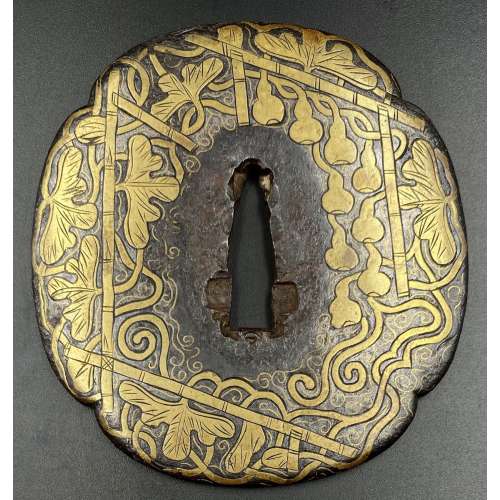
Iron tsuba of mokko form decorated with trellis, vines, foliage, and gourds inlaid in brass with details carved in low relief.
NBTHK: Tokubetsu Hozon №2003186.
Momoyama period (1574 – 1603). Dimensions: H: 85.5 cm, W: 79 mm, Thickness (centre): 4.8 mm. Tsuba of a similar design can be found in this collection [TSU-0373]. In that example, the plate was later pierced with geometrical mon-like openwork to resemble Koike Yoshirō's handguards. More about this type of tsuba here.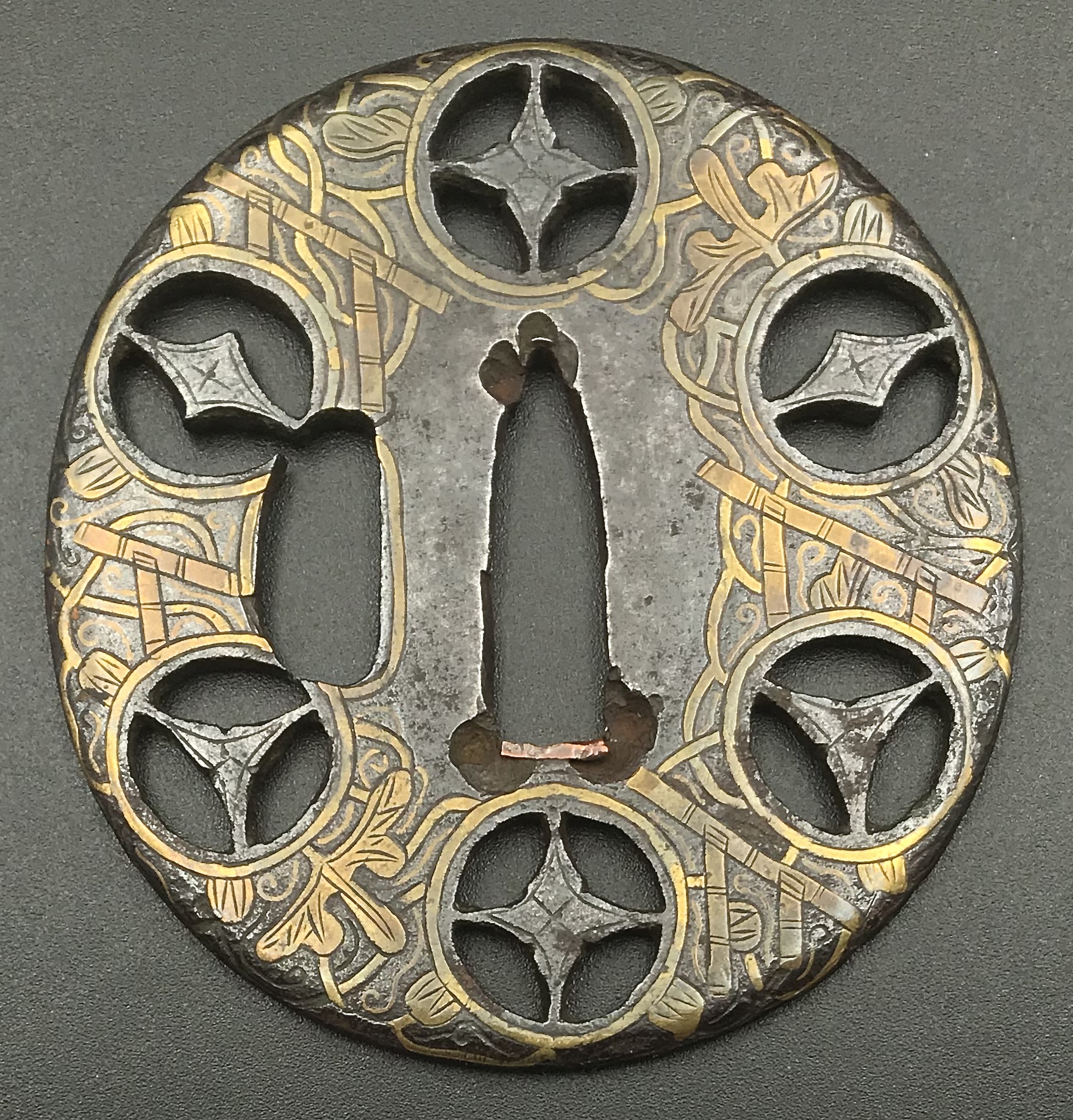
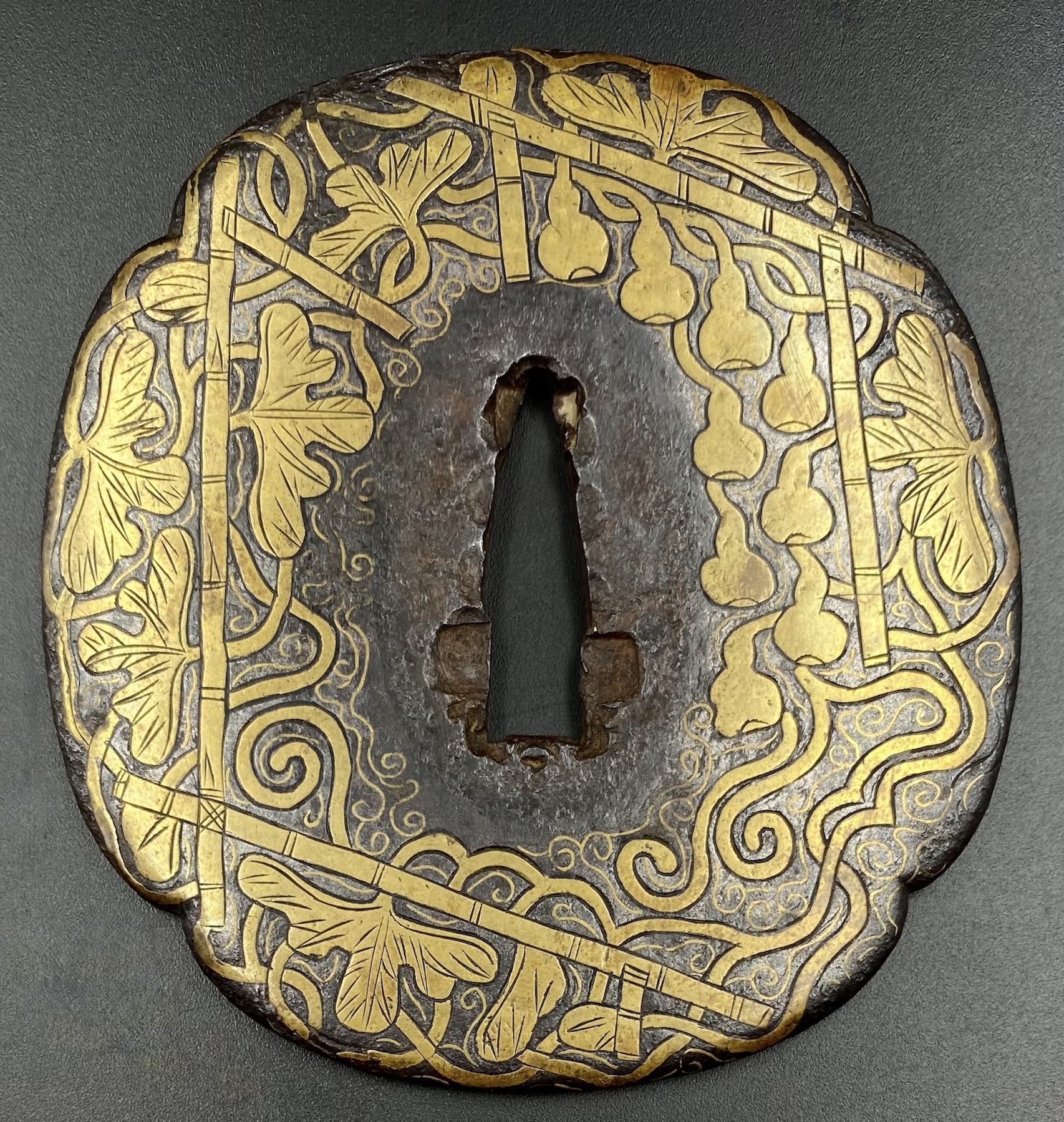
-

Tsuba of oval form decorated with vines, tendrils, and leaves on trellis in brass inlay with details carved in kebori, and pierced with six family crests (mon) with two, three and four pointing stars in openwork, each outlined with brass wire and carved in kebori. Original hitsu-ana outlined with brass wire was probably enlarged later. Copper sekigane.
Momoyama to early Edo period (end of the 16th - beginning of the 17th century). Dimensions: 68.3 x 64.5 x 3.4 mm. -

Tsuba of oval form decorated with clematis six-petal flowers, tendrils, and leaves in cast brass with details carved in kebori, inlaid on iron plate carved in low relief (kebori and sukidashi-bori). Hitsu-ana plugged with shakudō. Copper sekigane.
Heianjō (or Ōnin) school. Unsigned. Mid Muromachi period (1454-1513). Dimensions: 87.2 x 84.3 x 4.3 mm. Tsuba is illustrated and described in Gary D. Murtha's "Onin-Heianjo-Yoshiro" book on pages 38-39. Mid-Muromachi is the age attribution by Gary. “A picture book of Japanese sword guards. Victoria & Albert Museum“, published in 1927 presents us with a somewhat similar tsuba: "Floral ornament. Iron, with brass incrustation". V&A attributes the tsuba to Ōnin style, 16th century.
-
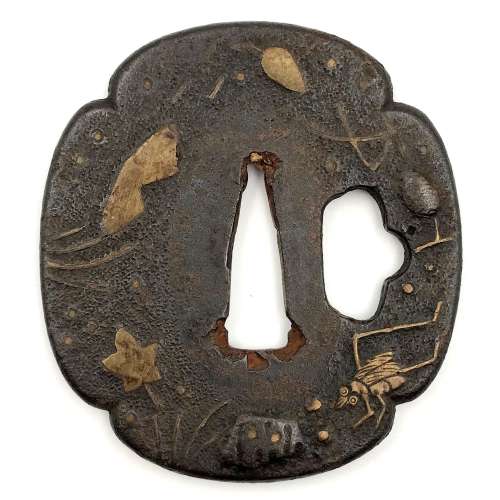 Iron tsuba of four-lobbed mokkō form decorated in brass and shakudō inlay on the face with design of rotten skull, fly, maple leaf, pine cones and needles, and on the back with design of rotten skull, wild boar, pine cones and needles. Scattered brass dots on both sides. Hitsu-ana possibly cut off later. Surface has traces of lacquer (urushi). Momoyama period. Dimensions: 67.3 x 61.5 x 4.3 mm A similar example can be found at Tsuba Kanshoki by Kazutaro Torogoye, 1975 on p. 61: "Heianjōzōgan tsuba. No sig. Iron: Pine-cone, seeds, ants & rock, brass zōgan. Kakumimi: C. 1.5 bu. Age: Momoyama. Sup. - Early work. Interest."
Iron tsuba of four-lobbed mokkō form decorated in brass and shakudō inlay on the face with design of rotten skull, fly, maple leaf, pine cones and needles, and on the back with design of rotten skull, wild boar, pine cones and needles. Scattered brass dots on both sides. Hitsu-ana possibly cut off later. Surface has traces of lacquer (urushi). Momoyama period. Dimensions: 67.3 x 61.5 x 4.3 mm A similar example can be found at Tsuba Kanshoki by Kazutaro Torogoye, 1975 on p. 61: "Heianjōzōgan tsuba. No sig. Iron: Pine-cone, seeds, ants & rock, brass zōgan. Kakumimi: C. 1.5 bu. Age: Momoyama. Sup. - Early work. Interest."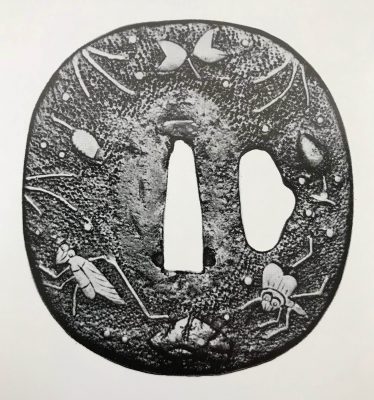
Tsuba Kanshoki, 1975, p. 61: Heianjō tsuba, Momoyama Period.
-

Iron tsuba of mokkō form (mokkōgata) pierced (sukashi) and inlaid with precast dark brass inlay (taka-zōgan) with somewhat abstract/geometrical design that can be liberally described as pines, mist, and snow.
Momoyama or early Edo period. End of the 16th - beginning of the 17th century. Heianjō school. Unsigned. Dimensions: 86.8 x 82.9 x 4.5 mm. -
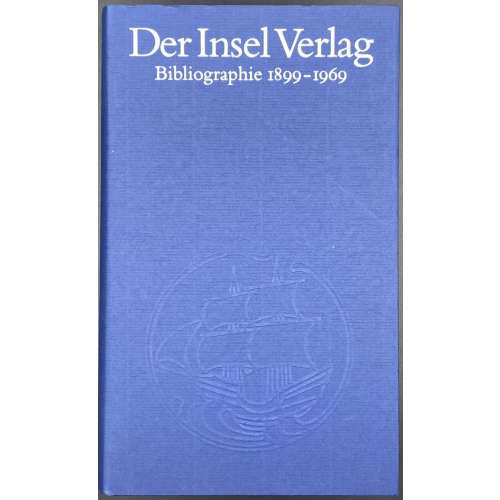 Title: DER INSEL VERLAG | EINE BIBLIOGRAPHIE | 1899-1969 | […] Bearbeitet und herausgegeben | von Heinz Sarkowski | INSEL VERLAG || Pagination: [i-vi] vii-xiii [xiv] [2] 1-452. Binding: Blue cloth, black label with gilt lettering to spine, lettered and blind-stamped DJ.
Title: DER INSEL VERLAG | EINE BIBLIOGRAPHIE | 1899-1969 | […] Bearbeitet und herausgegeben | von Heinz Sarkowski | INSEL VERLAG || Pagination: [i-vi] vii-xiii [xiv] [2] 1-452. Binding: Blue cloth, black label with gilt lettering to spine, lettered and blind-stamped DJ. -
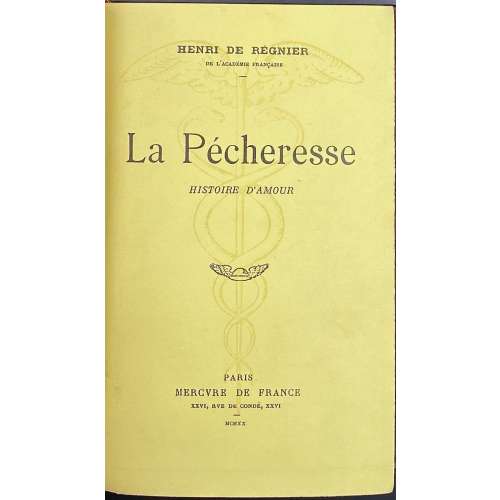 Hardcover volume, 19 x 13 cm, collated in-12mo, bound by Henri Creuzevault (signed) in full crushed brown morocco, spine with raised bands, gilt lettering “H. DE RÉGNIER | – | LA PÉCHERESSE” and “PARIS 1920” in the bottom compartment; gilt fillet to cover margin, five gilt fillets inside, marbled endpapers, bookplate of J.-P. Dutel to flyleaf, original yellow publisher’s wrappers preserved, top edge gilt, in a marbled slipcase; printed on dense wove paper (Japon). Inset: Receipt from Librairie ancienne et modern – Georges Venot (Lyon), dated April 16, 1938. Title-page / Cover: HENRI DE RÉGNIER | DE L’ACADÉMIE FRANÇAISE | – | La Pécheresse | HISTOIRE D’AMOUR | {publisher’s device} | PARIS | MERCVRE DE France | XXVI, RVE DE CONDÉ, XXVI | MCMXX || Limitation: 158 copies on Japon (№№ 1-158), 95 copies on Chine (№№ 159-253), 515 copies on Hollande (№№ 254-768), 1,650 copies on vélin pur fil de Lafuma (№№ 769-2393, and 25 copies not for sale marked A-Z. This is № 75 (on Japon), a unique copy enriched with 7 original watercolours by Serge de Solomko. Collation: 3 blank flyleaves, front wrapper, π6 (1 h.t./advert., 1 t.p./limit., 1 dedication, 3), 1-206, 212, back wrapper, spine, 3 blank flyleaves, list of illustrations pasted to recto endpaper “La Pécheresse. | 7 aquarelles de Solemko (sic.) | 57, 64, 168, 256, 289, 320, 346”, seven plates bound in as per the list. Pagination: [1-5] 6-350, ils. OCLC Number / Unique Identifier: 715077259. Contributors: Henri de Régnier (French, 1864 – 1936) – author. Auguste Gilbert de Voisins (1877 – 1939) – dedicatee. Sergueï Solomko [Сергей Сергеевич Соломко, Serge de Solomko] (Russian-French, 1867 – 1928) – artist. Henri Creuzevault (French, 1905 – 1971) – bookbinder. J.-P. Dutel description: RÉGNIER, Henri de. LA PECHERESSE. Paris, Mercure de France, 1920. In-12 (18,3 x 11,4 cm) de [1] f., 350 pp., maroquin janséniste grenat, dos à 5 nerfs, filets dorés intérieurs, tête dorée, filets dorés sur les coupes, non rogné, couverture et dos conservés, étui bordé. (Creuzevault). ÉDITION ORIGINALE. Tirage : 95 ex. sur chine. 158 ex. sur japon. 515 ex. sur hollande. UN DES 158 EXEMPLAIRES SUR JAPON. EXEMPLAIRE UNIQUE ENRICHI DE 7 AQUARELLES ORIGINALES HORS-TEXTE SIGNÉES PAR SERGE DE SOLOMKO. Sergueï Sergueïevitch Solomko « Serge de Solomko », (Saint-Petersburg, 1867- Sainte Geneviève des bois, 1928) est un illustrateur, graphiste et aquarelliste russe qui vécut en partie en France. Qualifiée d'histoire d'amour, cette œuvre d'Henri de Régnier est dédiée à Gilbert de Voisins, poète et romancier, en témoignage de fraternelle amitié. Elle est placée par son auteur sous les auspices du moraliste et critique libertin Saint-Evremond dont une citation figure en exergue du livre : « Il y a des temps où l'on pleure les plaisirs perdus, des temps où l'on pleure les péchés commis. » Et l'auteur d'incipiter comme suit : « J'ai toujours été si curieux des particularités que l'on découvre au caractère des femmes que, pas une fois, je n'ai négligé de m'instruire sur le sujet. » « (...) le point où se montre le mieux et le plus ouvertement ce que la nature les a faites, est celui de l'amour. »
Hardcover volume, 19 x 13 cm, collated in-12mo, bound by Henri Creuzevault (signed) in full crushed brown morocco, spine with raised bands, gilt lettering “H. DE RÉGNIER | – | LA PÉCHERESSE” and “PARIS 1920” in the bottom compartment; gilt fillet to cover margin, five gilt fillets inside, marbled endpapers, bookplate of J.-P. Dutel to flyleaf, original yellow publisher’s wrappers preserved, top edge gilt, in a marbled slipcase; printed on dense wove paper (Japon). Inset: Receipt from Librairie ancienne et modern – Georges Venot (Lyon), dated April 16, 1938. Title-page / Cover: HENRI DE RÉGNIER | DE L’ACADÉMIE FRANÇAISE | – | La Pécheresse | HISTOIRE D’AMOUR | {publisher’s device} | PARIS | MERCVRE DE France | XXVI, RVE DE CONDÉ, XXVI | MCMXX || Limitation: 158 copies on Japon (№№ 1-158), 95 copies on Chine (№№ 159-253), 515 copies on Hollande (№№ 254-768), 1,650 copies on vélin pur fil de Lafuma (№№ 769-2393, and 25 copies not for sale marked A-Z. This is № 75 (on Japon), a unique copy enriched with 7 original watercolours by Serge de Solomko. Collation: 3 blank flyleaves, front wrapper, π6 (1 h.t./advert., 1 t.p./limit., 1 dedication, 3), 1-206, 212, back wrapper, spine, 3 blank flyleaves, list of illustrations pasted to recto endpaper “La Pécheresse. | 7 aquarelles de Solemko (sic.) | 57, 64, 168, 256, 289, 320, 346”, seven plates bound in as per the list. Pagination: [1-5] 6-350, ils. OCLC Number / Unique Identifier: 715077259. Contributors: Henri de Régnier (French, 1864 – 1936) – author. Auguste Gilbert de Voisins (1877 – 1939) – dedicatee. Sergueï Solomko [Сергей Сергеевич Соломко, Serge de Solomko] (Russian-French, 1867 – 1928) – artist. Henri Creuzevault (French, 1905 – 1971) – bookbinder. J.-P. Dutel description: RÉGNIER, Henri de. LA PECHERESSE. Paris, Mercure de France, 1920. In-12 (18,3 x 11,4 cm) de [1] f., 350 pp., maroquin janséniste grenat, dos à 5 nerfs, filets dorés intérieurs, tête dorée, filets dorés sur les coupes, non rogné, couverture et dos conservés, étui bordé. (Creuzevault). ÉDITION ORIGINALE. Tirage : 95 ex. sur chine. 158 ex. sur japon. 515 ex. sur hollande. UN DES 158 EXEMPLAIRES SUR JAPON. EXEMPLAIRE UNIQUE ENRICHI DE 7 AQUARELLES ORIGINALES HORS-TEXTE SIGNÉES PAR SERGE DE SOLOMKO. Sergueï Sergueïevitch Solomko « Serge de Solomko », (Saint-Petersburg, 1867- Sainte Geneviève des bois, 1928) est un illustrateur, graphiste et aquarelliste russe qui vécut en partie en France. Qualifiée d'histoire d'amour, cette œuvre d'Henri de Régnier est dédiée à Gilbert de Voisins, poète et romancier, en témoignage de fraternelle amitié. Elle est placée par son auteur sous les auspices du moraliste et critique libertin Saint-Evremond dont une citation figure en exergue du livre : « Il y a des temps où l'on pleure les plaisirs perdus, des temps où l'on pleure les péchés commis. » Et l'auteur d'incipiter comme suit : « J'ai toujours été si curieux des particularités que l'on découvre au caractère des femmes que, pas une fois, je n'ai négligé de m'instruire sur le sujet. » « (...) le point où se montre le mieux et le plus ouvertement ce que la nature les a faites, est celui de l'amour. » -
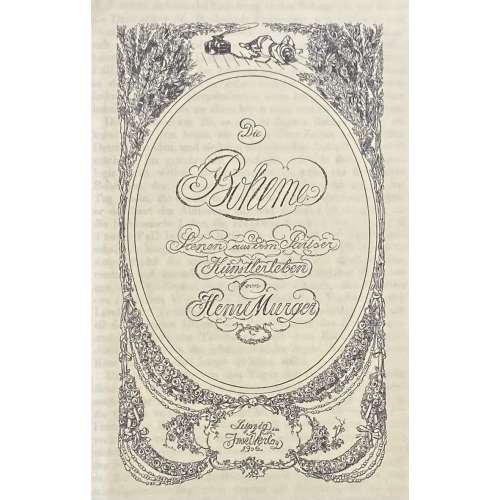 Pictorial title by von Bayros: Die | Bohème. | Scenen aus dem Pariser | Künstlerleben | von | Henri Murger | Leipzig im | InselVerlag | 1906. | F. Bayros || Pagination: [2] – pictorial frontispiece, [2] – pictorial t.p., 1-280 [2] – inhalt, [2] – colophon, [2] – blank, + 4 plates drawn by Franz von Bayros and reproduced as photogravure, with guards. Binding: 23.5 x 15.5 cm, cream parchment, raised bands, gilt-lettered orange morocco label to spine; text printed on laid paper (Linden Paper watermark), untrimmed, illustrations on wove paper as photogravure. Bookplate: “Ex libris Walter Schniewind” engraved by C. L. Becker. Original title: Henry Murger. Scenes De La Vie De Boheme. — Paris: Michel Lévy frères, 1851. Tirage: 50 copies on laid paper, of which this is № 14 (per Sarkowski: 50 numerierte Ex. auf Bütten. Pergament mit Goldschnitt). Author: Murger, Henri [Murger, Louis-Henri, Henry] (French, 1822 – 1861). Translator: Grove, Frederick Philip [Greve, Felix Paul] (German-Canadian, 1879 – 1948). Illustrator: Bayros, Franz von (Austrian, 1866 – 1924). Printer: Drugulin, Wilhelm Eduard (German, 1822 – 1879); Offizin W. Drugulin (Leipzig). Provenance: Schniewind, Walter (German, 1870 – 1927). Catalogue raisonné: Heinz Sarkowski (1999): № 1175 VA, p. 195; Bayros Zeichnungen, pp. 43-46.
Pictorial title by von Bayros: Die | Bohème. | Scenen aus dem Pariser | Künstlerleben | von | Henri Murger | Leipzig im | InselVerlag | 1906. | F. Bayros || Pagination: [2] – pictorial frontispiece, [2] – pictorial t.p., 1-280 [2] – inhalt, [2] – colophon, [2] – blank, + 4 plates drawn by Franz von Bayros and reproduced as photogravure, with guards. Binding: 23.5 x 15.5 cm, cream parchment, raised bands, gilt-lettered orange morocco label to spine; text printed on laid paper (Linden Paper watermark), untrimmed, illustrations on wove paper as photogravure. Bookplate: “Ex libris Walter Schniewind” engraved by C. L. Becker. Original title: Henry Murger. Scenes De La Vie De Boheme. — Paris: Michel Lévy frères, 1851. Tirage: 50 copies on laid paper, of which this is № 14 (per Sarkowski: 50 numerierte Ex. auf Bütten. Pergament mit Goldschnitt). Author: Murger, Henri [Murger, Louis-Henri, Henry] (French, 1822 – 1861). Translator: Grove, Frederick Philip [Greve, Felix Paul] (German-Canadian, 1879 – 1948). Illustrator: Bayros, Franz von (Austrian, 1866 – 1924). Printer: Drugulin, Wilhelm Eduard (German, 1822 – 1879); Offizin W. Drugulin (Leipzig). Provenance: Schniewind, Walter (German, 1870 – 1927). Catalogue raisonné: Heinz Sarkowski (1999): № 1175 VA, p. 195; Bayros Zeichnungen, pp. 43-46. -
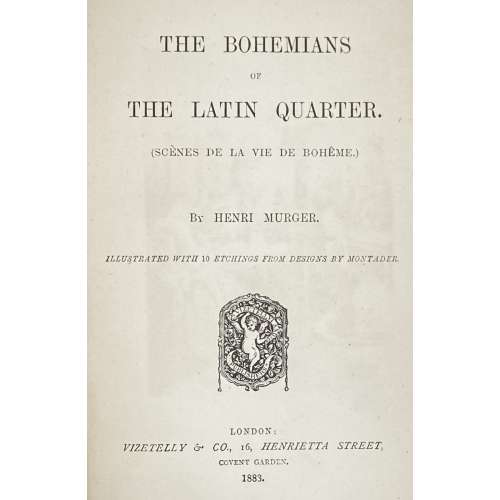 Title: THE BOHEMIANS | OF | THE LATIN QUARTER. | (SCÈNES DE LA VIE DE BOHÊME.) | By HENRI MURGER. | ILLUSTRATED WITH 10 ETCHINGS FROM DESIGNS BY MONTADER. |{publisher’s device}| LONDON: | VIZETELLY & CO., 16, HENRIETTA STREET, | COVENT GARDEN. | 1888. || Pagination: [i-v] vi-xxxiv, [1] 2-317 [318 blank]; collation: 8vo, π1 (h.t.), [a]-b8, B-U8 X7 + 10 etchings by Charles Courtry after Alfred Montader (incl. frontispiece and portrait of Henri Murger). Binding: 23 x 14.5 cm, olive cloth, black lettering to cover and gilt lettering to spine. Contributors: Murger, Henri [Henry] (French, 1822 – 1861) – original text (French). Montader, Pierre Marie Alfred (French, fl. c. 1881 – 1925) – artist. Courtry, Charles Jean Louis (French, 1846 – 1897) – engraver. Vizetelly, Henry Richard (British, 1820 – 1894) – publisher.
Title: THE BOHEMIANS | OF | THE LATIN QUARTER. | (SCÈNES DE LA VIE DE BOHÊME.) | By HENRI MURGER. | ILLUSTRATED WITH 10 ETCHINGS FROM DESIGNS BY MONTADER. |{publisher’s device}| LONDON: | VIZETELLY & CO., 16, HENRIETTA STREET, | COVENT GARDEN. | 1888. || Pagination: [i-v] vi-xxxiv, [1] 2-317 [318 blank]; collation: 8vo, π1 (h.t.), [a]-b8, B-U8 X7 + 10 etchings by Charles Courtry after Alfred Montader (incl. frontispiece and portrait of Henri Murger). Binding: 23 x 14.5 cm, olive cloth, black lettering to cover and gilt lettering to spine. Contributors: Murger, Henri [Henry] (French, 1822 – 1861) – original text (French). Montader, Pierre Marie Alfred (French, fl. c. 1881 – 1925) – artist. Courtry, Charles Jean Louis (French, 1846 – 1897) – engraver. Vizetelly, Henry Richard (British, 1820 – 1894) – publisher. -
![Henri Rollin. L'apocalypse de notre temps / Les dessous de la propagande allemande d'après des documents inédits. — NRF [Nouvelle Revue Française], — Paris: Gallimard, 1939. — Series: Problémes et documents. pp.: [1-9] 10-567 [9].](https://varshavskycollection.com/wp-content/uploads/2021/02/LIB-0371.2015-a-500x500.jpeg) Title: PROBLÈMES ET DOCUMENTS | HENRI ROLLIN | L'APOCALYPSE | DE | NOTRE TEMPS | Les dessous de la propagande allemande | d'après des documents inédits | nrf | S. P. | GALLIMARD | Paris — 43, rue de Beaune Pagination: [1-9] 10-567 [9]. Size: 22.6 x 14.2 cm Binding: original publisher's wrappers. Ex libris Lorenzo Grazzini of Librairie Scritti (book store in Paris). Publishing Year: 1939; Publisher: Gallimard; Acheve d'impremier - Le 23 Septembre 1939 par l'Impremierie Orleanaise 68, rue Royale, Orleans.
Title: PROBLÈMES ET DOCUMENTS | HENRI ROLLIN | L'APOCALYPSE | DE | NOTRE TEMPS | Les dessous de la propagande allemande | d'après des documents inédits | nrf | S. P. | GALLIMARD | Paris — 43, rue de Beaune Pagination: [1-9] 10-567 [9]. Size: 22.6 x 14.2 cm Binding: original publisher's wrappers. Ex libris Lorenzo Grazzini of Librairie Scritti (book store in Paris). Publishing Year: 1939; Publisher: Gallimard; Acheve d'impremier - Le 23 Septembre 1939 par l'Impremierie Orleanaise 68, rue Royale, Orleans. -
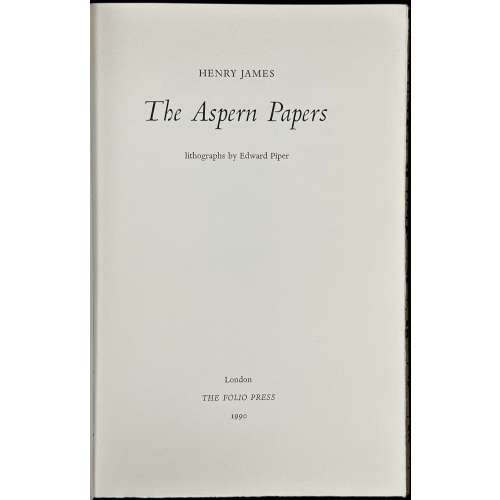 Hardcover volume, 21.5 x 14.7 x 5.7 cm, bound in red cloth with blind-stamped ms signature to front board and gilt lettering over black labels, and gild design elements to spine; pp.: [i-iv] (h.t./blank, t.p./copyright) v-xv[xvi] blank, [1-2] f.t./blank, 3-1653 [1654] blank, [2] publ. note/blank; 1672 pp total; Blue ink ms inscription to h.t. 'Lawrence Wyman'. Title-page (in a two-rule frame): THE COMPLETE WORKS OF | O. Henry | Foreword by | WILLIAM LYON PHELPS | AUTHENTIC EDITION | {publisher’s device, G.C.P.} | De Luxe Edition | — | Garden City Publishing Co., Inc. | GARDEN CITY NEW YORK || Contributors: O. Henry [William Sydney Porter] (American, 1862 – 1910) – author. William Lyon Phelps (American, 1865 – 1943) – author/foreword.
Hardcover volume, 21.5 x 14.7 x 5.7 cm, bound in red cloth with blind-stamped ms signature to front board and gilt lettering over black labels, and gild design elements to spine; pp.: [i-iv] (h.t./blank, t.p./copyright) v-xv[xvi] blank, [1-2] f.t./blank, 3-1653 [1654] blank, [2] publ. note/blank; 1672 pp total; Blue ink ms inscription to h.t. 'Lawrence Wyman'. Title-page (in a two-rule frame): THE COMPLETE WORKS OF | O. Henry | Foreword by | WILLIAM LYON PHELPS | AUTHENTIC EDITION | {publisher’s device, G.C.P.} | De Luxe Edition | — | Garden City Publishing Co., Inc. | GARDEN CITY NEW YORK || Contributors: O. Henry [William Sydney Porter] (American, 1862 – 1910) – author. William Lyon Phelps (American, 1865 – 1943) – author/foreword. -
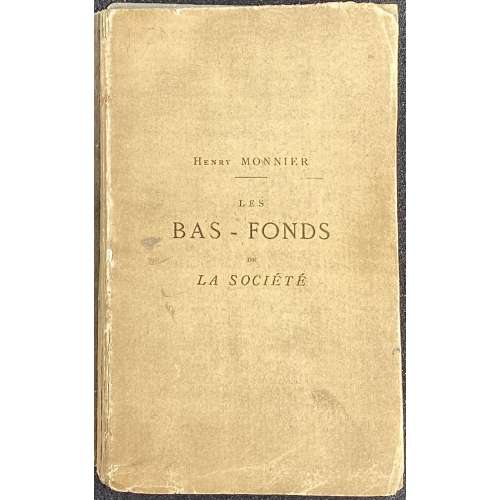 Small softcover volume, ‘édition minuscule’ in-32, 13 x 8 cm, publisher’s wrappers, pp.: [1-6] (h.t., t.p., advert.), [7] 8-160 [2 table/blank], included in pagination 8 pasted etchings on India paper after Félicien Rops and one blank leaf next to plate 1; laid paper with watermarks, some pages uncut. Title-page: DOCUMENTS | POUR SERVIR A L’HISTOIRE DE NOS MŒURS | – | LES | BAS-FONDS | DE LA SOCIÉTÉ | PAR | HENRY MONNIER | AVEC | 8 dessins à la plume | de F. R. | {fleuron} | ÉDITION MINUSCULE | tirée | à 64 exemplaires. || Pencil handwriting on top: 8 gravures de Felicien Rops | 250 –, in the bottom: [1879]. Print run: 64 copies; clandestine edition. Catalogue raisonné: Vicaire V, 1019; Bory p. 100 (though here is the frontispiece for Les Bas-fonds de la société par Joseph Prudhomme [Henry Monnier], 1864, with all the sheets together; Dutel I, A-134. Ref: (1) Poulet-Malassis & ses amis № 90 [LIB-3118.2022] ; (2) Félicien Rops: L'oeuvre graphique complète. / Ouvrage établi et présenté par Jean-François Bory. Avec un texte contemporain de l'artiste par J. K. Huysmans. — Arthur Hubschmidt, 1977. [LIB-2241.2019] Contributors: Henry Monnier (French, 1799 – 1877) – author. Félicien Rops (Belgian, 1833 – 1898) – artist. Henry Kistemaeckers (Belgian, 1851 – 1934) – publisher. Auguste Poulet-Malassis (French, 1825 – 1878)
Small softcover volume, ‘édition minuscule’ in-32, 13 x 8 cm, publisher’s wrappers, pp.: [1-6] (h.t., t.p., advert.), [7] 8-160 [2 table/blank], included in pagination 8 pasted etchings on India paper after Félicien Rops and one blank leaf next to plate 1; laid paper with watermarks, some pages uncut. Title-page: DOCUMENTS | POUR SERVIR A L’HISTOIRE DE NOS MŒURS | – | LES | BAS-FONDS | DE LA SOCIÉTÉ | PAR | HENRY MONNIER | AVEC | 8 dessins à la plume | de F. R. | {fleuron} | ÉDITION MINUSCULE | tirée | à 64 exemplaires. || Pencil handwriting on top: 8 gravures de Felicien Rops | 250 –, in the bottom: [1879]. Print run: 64 copies; clandestine edition. Catalogue raisonné: Vicaire V, 1019; Bory p. 100 (though here is the frontispiece for Les Bas-fonds de la société par Joseph Prudhomme [Henry Monnier], 1864, with all the sheets together; Dutel I, A-134. Ref: (1) Poulet-Malassis & ses amis № 90 [LIB-3118.2022] ; (2) Félicien Rops: L'oeuvre graphique complète. / Ouvrage établi et présenté par Jean-François Bory. Avec un texte contemporain de l'artiste par J. K. Huysmans. — Arthur Hubschmidt, 1977. [LIB-2241.2019] Contributors: Henry Monnier (French, 1799 – 1877) – author. Félicien Rops (Belgian, 1833 – 1898) – artist. Henry Kistemaeckers (Belgian, 1851 – 1934) – publisher. Auguste Poulet-Malassis (French, 1825 – 1878)


